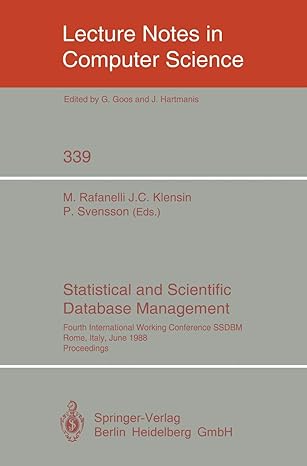Question
Section 1: multiple choice Data Types: The following is what data type: number = 23 a.string b.float c.list d.integer. e.dictionary The following is what data
Section 1: multiple choice
Data Types:
The following is what data type:
number = 23
a.string
b.float
c.list
d.integer.
e.dictionary
The following is what data type:
number = "
Hello World!
"a.string
b.float
c.list
d.integer
e.dictionary
The following is what data type:
shopping_list = {1: "kale",
2: "almond milk",
3: "olive oil",
4: "walnuts"}
a.string
b.float
c.list
d.integer
e.dictionary
The following is what data type:
class_list = ["differential equations",
"python for finance",
"data structures",
"algorithms"]
a.string
b.float
c.list
d.integer
e.dictionary
If you wanted to find out the type of a variable in Python called number, which command would you use?
A.type(number)
B.typeof(number)
C.number.class
Section 2: programming
Program 1:
Account management of our software has a request from a
client to build a basic calculator using python that has the following
criteria:
input your choice 1 4 (these get added as functions)
1 is to add
2 is to subtract
3 is to multiply
4 is to divide
print out what you chose in terms of if you picked 2 it would say
you chose to subtract
enter number 1 as x
enter number 2 as y
print out the answer
Here is an example of one of the functions (you need 4)
# example of one of the calculator functions
def add(x, y) :
return x + y
Here is an example of printing out your choice:
Choice_dictionary = {1: "add",
2: "subtract",
3. "multiply",
4. "divide"}
for i in choice_dictionary:
if choice == i:
print "you chose: " + choice_dictionary[i]
Section 3:
Pi = Poert
P means population. Po is population start and Pi is population finish.
It basically means how much population growth happens.
e is a constant and is approximately 2.718281828
you can also import math and go math.e
r is the growth rate which has to be converted to a decimal by dividing by 100. So if growth rate is 1.6, it is 0.16 by making it 1.6/100
t is time. So it can be hours in terms of bacteria or years in terms of population growth. This also works for money growth.
Write a function that returns the population growth number.
The arguments you need to pass into the function is
P = starting population
r = population growth rate
t = time
and it should return the finishing population.
If the starting population in the US in 1920 was 100 million, and the growth rate is approximately 1.234 from 1920 to 2014. What does your final population give? It should be around 318 million
Step by Step Solution
There are 3 Steps involved in it
Step: 1

Get Instant Access to Expert-Tailored Solutions
See step-by-step solutions with expert insights and AI powered tools for academic success
Step: 2

Step: 3

Ace Your Homework with AI
Get the answers you need in no time with our AI-driven, step-by-step assistance
Get Started


